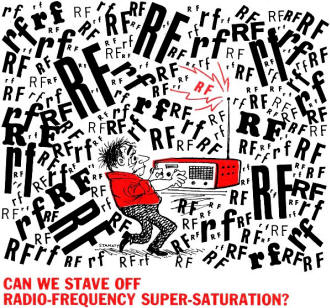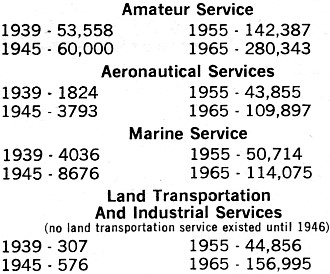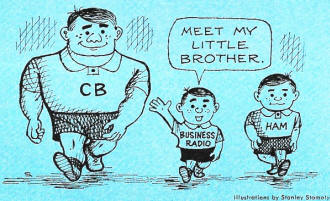|
October 1967 Popular Electronics
 Table of Contents
Table of Contents
Wax nostalgic about and learn from the history of early electronics. See articles
from
Popular Electronics,
published October 1954 - April 1985. All copyrights are hereby acknowledged.
|
Spectrum crowding issues
began almost as soon as wireless communications was started. Early spark transmitters
spewed RF radiation all over the place, and (nearly) filterless receivers picked it
up to convert the simple CW (continuous wave) signals into dits and dahs from Morse
code messages. As more people climbed onto the radio bandwagon with ever increasing
transmitter power levels and receiver sensitivity levels, differentiating between
desirable and undesirable signals became a frustrating task - like trying to hold a
conversation in a room full of yakking people. Filters on transmitters and receivers
provided much relief. User numbers continued to grow and phone (voice)
communications, which occupies a few kilohertz of bandwidth instead of only a hundred
or so Hz, started straining spectrum availability again. Newer modulation techniques
like single sideband freed up some space, but then the digital age came along and
started sucking up spectrum yet again. During the entire time, advances in electronic
components and circuit design (particularly filtering) continually expanded usable
frequencies higher and higher into the GHz realm, but like gas expanding to fill the
available volume, uses for and the resulting occupations of the RF spectrum never
gets a break. Unquestionably the largest single contributor to easing spectrum
crowding are spread spectrum digital techniques. WiFi, Bluetooth, wireless security,
and cellphones would never work acceptably without it.
My lifelong hobby of flying model aircraft has benefitted immeasurably from spread
spectrum techniques by having virtually eliminated frequency contention issues that
all too often caused airborne planes to crash when some moron nearby switched on his
transmitter without making sure nobody else was using the assigned frequency
(previous radio control systems used AM and FM pulse coded modulation on discrete
72 MHz channels).
Can We Stave Off Radio-Frequency Super-Saturation?
 North America is Rapidly Running Out of Usable Radio Frequencies - How Did it Happen? North America is Rapidly Running Out of Usable Radio Frequencies - How Did it Happen?
By Richard Humphrey
Users of two-way radio communications facilities have looked with horror upon the
congestion and glut on the 23 Citizens Band channels. Many users take the viewpoint that
this congestion may be a warning of things to come on all two-way radio channels. It
is becoming increasingly apparent that there are a lot of people using two-way radio
and just as many wanting to get on the air as soon as they can.
Radio users in North America are not the only ones concerned. Two-way radio usage
in Europe and South America is increasing at an astonishing rate. All users are being
made to face up to the fact that the radio frequency spectrum is fast approaching the
super-saturation point.
In New York City, a realty concern was forced to give up its two-way radio communications
system because, "We could never get through to each other due to the congestion." The
U.S. Coast Guard says that the marine calling and distress frequency (2182 kHz) is almost
useless at certain times of the year because of the congestion and interference.
Much of the two-way land mobile radio communications is now - out of sheer desperation
- migrating to the more expensive (from an equipment viewpoint) UHF channels. CB'ers
are making desultory moves toward a plan wherein they could acquire operating privileges
in a portion of the 10-meter amateur radio band. Actually, rumors abound that the FCC
may eventually give CB'ers some portion of the 6-meter band.
Law enforcement agencies, emergency services, fire departments, etc., are all pleading
for more two-way radio fre-quencies. The major metropolitan areas (New York City, Los
Angeles, etc.) must have more radio space or be strangled within the next few years by
lack of radio communications. The aeronautical service is caught in a fantastic air traffic
explosion, with more planes, more airline flights, more airports, etc., all demanding
radio frequencies.
The Federal Communications Commission is toying with
the idea of channel splitting in the VHF/FM business band, which would effectively double
the number of available frequencies, but is encountering opposition. Some halving of
channel space is already afoot in England, however.
"Land mobile radio in Britain," said J. R. Brinkley of Pye Telecommunications, Ltd.,
"is now embarking on the changeover to 12.5-kHz channel spacing."
A few years ago the FCC attempted to break the communications log jam in the 2-3 MHz
marine band through the creation of several channels in the VHF/FM band. As this is being
written, channel-splitting in this new VHF band is expected to take place in a few months.
 Too Many Services. Many people aren't aware of the number and variety
of FCC regulated radio communications services that are fighting for channel space. Each
service has its own particular set of woes. How many of the following radio services
did you suspect even existed? Too Many Services. Many people aren't aware of the number and variety
of FCC regulated radio communications services that are fighting for channel space. Each
service has its own particular set of woes. How many of the following radio services
did you suspect even existed?
Most of the services just listed are crowded into the VHF spectrum where they share
(proportionately) a miniscule amount of frequency space in relation to the spectrum allocated
for FM and TV broadcasting.
The largest property owner in the radio frequency spectrum is the broadcast industry.
It has the right to 82% of all non-government radio frequency allocations below 1000
MHz. In a span of only seven years (1958-1965), the number of licenses to broadcasting
stations increased 60 %.
Television broadcasting is a real frequency user. Each TV channel extends over a bandwidth
of 6 MHz. Since the AM broadcasting band extends from, roughly, 550 to 1600 kHz, this
means that each TV channel could contain almost six commercial AM broadcast bands!
The Frequency Grabber. Although broadcasting appears to hold a disproportionate share
of radio frequencies, the greatest frequency grabber is the U.S. Government! Roughly
speaking, just about 47% of the radio frequency spectrum below 40,000 MHz is allocated
to the U.S. Government! And only about 34% is placed under the control of the FCC for
non-government use.
Although the Government can find valid and sometimes justifiable reasons for some
of its exceptional frequency allocation, the fact remains that somewhere along the line
there must have been terrible mismanagement. When you tune from 2 to 50 MHz on any general-coverage
communications receiver, you will find a lot of wasteland - vacant channels, misused
channels and even redundant channels.
To put it bluntly, the U.S. Government is nothing but a gigantic frequency hog! Although,
privately, many Government officials admit that the situation is bad, few if any Government
services want to give up - even temporarily - their radio channels.
What Went Wrong? Most two-way radio communications users are unaware
that more than 80% of our present facilities came into being after the close of World
War II. From the 722 AM broadcast band stations on the air in 1939, and the 919 in 1945,
the total now has reached an astonishing level of 4153! Commercial FM broadcasting stations
grew from only 46 transmitters in 1945 to a grand total of 1744 in 1966.
 Radio station authorizations in the other radio services saw the same enormous growth: Radio station authorizations in the other radio services saw the same enormous growth:
It is no small wonder, considering the number of transmitters in operation, that in
1964 the Joint Technical Advisory Committee of the IEEE told all those who would listen
that all of our radio frequency space is in use and any major change would be difficult
to make because of the great amount of money that has been invested.
What Is Going to Happen? A few years ago, Irving Brownstein of the
FCC staff said that communications is a world "where frequency cannibalism may be a major
means of survival." In other words, if a radio service doesn't make sufficient and efficient
use of their radio frequency allocations, they may wake up some morning and find that
their channel is gone. Or, in a nutshell - "use it or lose it! "
Right now might be a good time for all radio amateurs to take a look at their total
frequency allocations. How many hams are using those 220-MHz-and-up bands? It is doubtful
that the ham is in a very secure position as far as the use or lose philosophy is concerned.
Powerful commercial interests are positive that they will secure frequency relief
within the foreseeable future. The influential AT&T has asked for 78 channels for
a public correspondence service; so far they have received only a piddling 18. The Ford
Foundation has proposed a TV satellite relay system which might help pay for educational
TV; although everyone admits that the idea is worthy, it's being opposed on the grounds
that there's no frequency space available. And what might happen if the CB'ers ever did
get organized and presented a united front to the FCC for more frequency space?
Somewhere there is a solution to this problem of frequency strangulation. Whether
it will be in the extension of the radio frequency spectrum or getting more out of what
we already have is an interesting problem. A possibility - being very seriously discussed
- is taking some radio services off the air. More than one "objectively-minded" engineer
is aware that radio and TV broadcasting could be carried throughout this country by land
coaxial cable or wire lines as well as by radio waves.
 One solution, with an eye towards unifying the fight against frequency poverty, is
contained in a recent Department of Commerce report by a panel of non-government experts.*
This panel recommended the creation of what might be called a "Super FCC." One solution, with an eye towards unifying the fight against frequency poverty, is
contained in a recent Department of Commerce report by a panel of non-government experts.*
This panel recommended the creation of what might be called a "Super FCC."
First, said the panel, this super-agency would find out who uses two-way radio communications
and what they are used for. Then, all users would be ranked as to their importance to
the national economy and how much their growth de-pended upon communications. This agency
would judge who was doing the best job all the way down to who was doing the worst job.
The Department of Commerce panel says coyly that it is "aware of the magnitude of the
difficulties and complexities" facing such a group, but then adds that the agency would
need a free hand.
Interestingly enough, the panel also criticized the "radio smog" generated by wireless
remote controls, wireless microphones, gadgets and toys, electronic appliances, electronic
industrial heaters, and various types of medical equipment.
In the early 1920's, well before these days of radio frequency congestion, glut, and
smog, numerous radio experimenters claimed that they had received signals from outer
space. There is always a chance that someone out there just might be listening to this
mess. What will we do when "they" decide to speak to us by radio? Answer? Or, give them
a citation for illegal transmissions? Somehow, this just doesn't seem to be a serious
problem. With all the radio frequency congestion, it's doubtful that we'll hear them.
* ''Electromagnetic Spectrum Utilization - The Silent Crisis", Telecommunications
Science Panel of the Department of Commerce Technical Board.
Posted November 15, 2018
|





























 Too Many Services. Many people aren't aware of the number and variety
of FCC regulated radio communications services that are fighting for channel space. Each
service has its own particular set of woes. How many of the following radio services
did you suspect even existed?
Too Many Services. Many people aren't aware of the number and variety
of FCC regulated radio communications services that are fighting for channel space. Each
service has its own particular set of woes. How many of the following radio services
did you suspect even existed?  Radio station authorizations in the other radio services saw the same enormous growth:
Radio station authorizations in the other radio services saw the same enormous growth:

